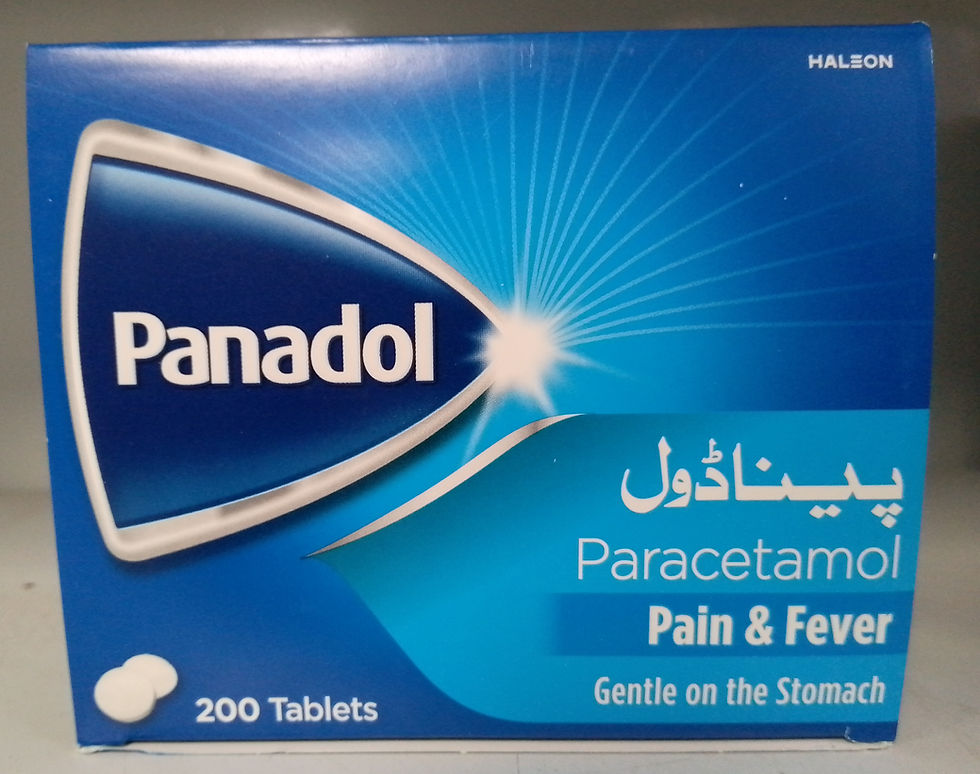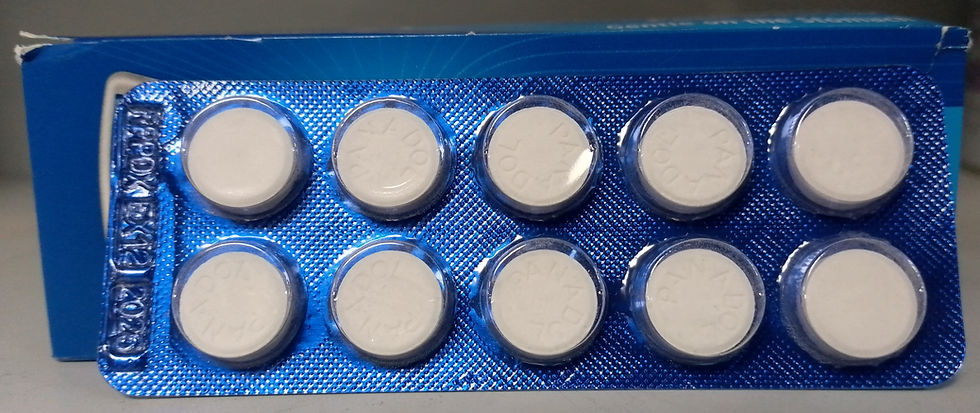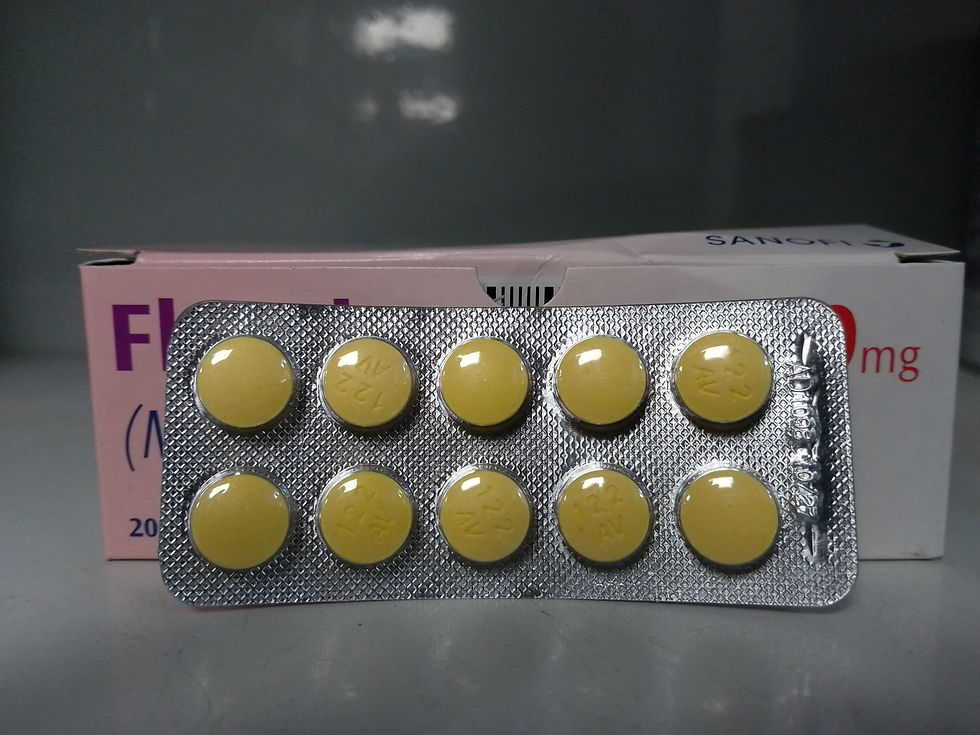panadol
- Dr Zahira Batool
- Apr 25
- 3 min read
Updated: May 9
پیناڈول
Written by Dr. Zahira Batool [PharmD, Qauid-e-Azam University, Islamabad, Pakistan]

Active ingredient:
Each tablet contains Paracetamol 500 mg.
Excipients:
Maize starch
Potassium sorbate (E 202)
Purified talc
Stearic acid
Povidone
Starch pregelatinised,
Hypromellose triacetin.
Pack size:
Box of 10 blisters x 12 tablets.
Price:
4 rs per tablet (0.047 dollars)
Manufacturer:
Haleon Pakistan
Therapeutic class:
Analgesic; Antipyretic
Pharmacological class:
Prostaglandin synthesis inhibitor
Indications:
For fast effective temporary relief of pain and discomfort associated
with headache, muscular aches, period pain, arthritis/osteoarthritis,
toothache, migraine headache, cold & flu symptoms, tension
headache, sinus pain/headache, and backache. Reduces fever.
Dosage and recommendation:
Do not exceed the stated dose. The lowest dose necessary to achieve
efficacy should be used for the shortest duration of time. Do not take
this medicine for more than 3 days without medical advice.
Dosage
Maximum day dose 60 mg/kg to be administered in divided doses of
10-15 mg/kg throughout the 24 hours
1. 12 years to adults:
1 to 2 tablets. Maximum daily dose: 8 tablets
2. 7 to 12 years:
½ to 1 tablet, Maximum daily dose: 4 tablets
3. Under 7 years:
Not recommended
Special population:
Renal Impairment:
Patients who have been diagnosed with renal impairment must seek
medical advice before taking this medication
Hepatic Impairment:
This has dose-related toxicity, so avoid large doses.
Method of administration:
Simply place the tablet(s) in your mouth and swallow them down with
water
Contra-indications:
These products are contraindicated in patients with a previous history
of hypersensitivity to paracetamol or any of the excipients.
Adverse effects:
Stop taking this medicine and tell your doctor immediately if:
• You experience allergic reactions such as skin rash or itching,
sometimes with breathing problems or swelling of the lips, tongue,
throat or face.
• You experience a skin rash or peeling, or mouth ulcers.
• You have previously experienced breathing problems with aspirin
or non-steroidal anti-inflammatory drugs and experience a similar
reaction with this product.
• You experience unexplained bruising or bleeding. These reactions
are rare.
Interactions:
Panadol shows interactions with the following drugs:
• Warfarin and other coumarins
• Chloramphenicol
• Hepatotoxic drugs
• Anticonvulsant drugs
• Probenecid
• Cholestyramine
Warnings and precautions:
1. Contains paracetamol. Do not use with any other
paracetamol-containing products. The concomitant use with
other products containing paracetamol may lead to an
overdose.
2. Paracetamol overdose may cause liver failure which can lead
to liver transplant or death.
3. Paracetamol should be used with caution in patients with:
• Impaired liver function: Underlying liver disease increases the
risk of paracetamol-related liver damage
• Impaired kidney function: Administration of paracetamol to
patients with moderate to severe renal impairment may result in
accumulation of paracetamol conjugates.
4. Patients who have been diagnosed with liver or kidney
impairment must seek medical advice before taking this
medication.
5. Cases of hepatic dysfunction/failure have been reported in
patients with depleted glutathione levels, such as those who
are severely malnourished, anorexic, have a low body mass
index or are chronic heavy users of alcohol. In patients with
glutathione-depleted states such as sepsis, the use of
paracetamol may increase the risk of metabolic acidosis.
6. If symptoms persist, medical advice must be sought.
7. Keep out of sight and reach of children.
Overdose:
Important: liver failure and less frequently renal damage can occur
following overdose. Underlying liver disease increases the risk of
paracetamol-related liver damage.
Symptoms and Signs:
Paracetamol overdose may cause liver failure which may require a liver
transplant or lead to death. Acute pancreatitis has been observed,
usually with hepatic dysfunction and liver toxicity. Nausea and
vomiting, the only early features of poisoning, usually settle within 24
hours. Persistence beyond this time, often associated with the onset of
right subcostal pain and tenderness, usually indicates the development of
hepatic necrosis
Treatment:
Immediate medical management is required in the event of an overdose,
even if symptoms of overdose are not present, refer the patient to the
nearest Emergency Medical Centre for management and expert
treatment. If an overdose is confirmed or suspected, seek immediate
advice from your Poison Centre even in patients without symptoms or
signs of overdose due to the risk of delayed liver damage.
Pregnancy:
As with the use of any medicine during pregnancy, pregnant women
should seek medical advice before taking paracetamol. The lowest
effective dose and shortest duration of treatment should be
considered.
Lactation:
Paracetamol is excreted in breast milk but not in a clinically
significant amount at recommended dosages. Available published data
do not contraindicate breastfeeding.
Clinical Pharmacology:
Its mechanism of action is believed to include inhibition of
prostaglandin synthesis, primarily within the central nervous system.
Storage:
Store below 35°C.





Comments